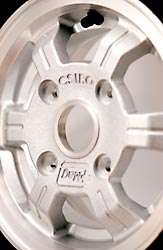Towards lower fuel use -- technologies for lighter cars

With oil prices at an historic high and global concern about vehicle emissions, consumer demand - and the focus in car manufacturing - is shifting to lightweight, low-fuel consumption cars.
CSIRO’s Light Metals Flagship recently showcased technologies which offer high-performance, light-weight car components at three US automotive industry conferences.
“Our technologies use magnesium and aluminium alloys to create strong, lightweight car parts which are cost-competitive with structural components made of steel, and perform equally well,” said Mr Barrie Finnin, until recently General Manager for Alloy Technologies with CSIRO Materials Science & Engineering.
“We aim to get the best performance out of lighter metals with efficient manufacturing techniques and minimum wastage of materials.”
Lightweight vehicle design - replacing existing automotive structural parts with light metal alternatives - is one of several complementary approaches to achieving lower fuel consumption.
Lighter cars use less fuel because they need less energy to start and stop than heavier cars.
Internationally, the automotive industry sees use of light metals and light alloys for car and truck components as a key means of creating of more fuel-efficient cars, through specific initiatives including the US FreedomCAR project and the NADIA European project.
Mr Finnin was invited to speak about technologies for cost reduction of light alloy components at the second Annual Advanced Lightweight Materials for Automotive conference, organised by the International Quality and Productivity Center, and held in June in Detroit.
The CSIRO technologies were also presented at CastExpo 2008 in Atlanta, Georgia, in May, and displayed at the Team Australia Automotive stand at the Society of Automotive Engineers World Congress in Detroit in April.
“Promotion of these technologies globally is essential to ensure their uptake within Australia,” Mr Finnin said.
“The large manufacturers specify the parts produced by local component makers for both export and domestic sales, so we need to promote them internationally.”
Australian exports of motor vehicles and automotive components were worth a total of $4.85 billion in 2006, according to the Federal Chamber of Automotive Industries.
The automotive sector is Australia’s largest manufacturing export earner, accounting for higher export earnings than traditional products including wine, wheat and wool.
Close to 70,000 people work in the sector, many of them for smaller companies producing components.
Evaluation of the technologies by major manufacturers is also critical to their uptake.
“Both our heat treatment and ATM technologies have been evaluated or trialled by major car component manufacturers, with positive results,” said Sam Tartaglia, business development manager, who was part of the Team Australia Automotive exhibit.
Both technologies enable production of high pressure die cast (HPDC) aluminium alloy parts which have increased strength, using reduced amounts of material.
“HPDC is an established technology already used in manufacturing vehicle components, so improvements are relatively easy for manufacturers to implement,” Mr Tartaglia said.
High volumes of structural and engine parts made by HPDC are used in the car industry, which makes them an attractive means of making lighter cars.
Provided by CSIRO





















